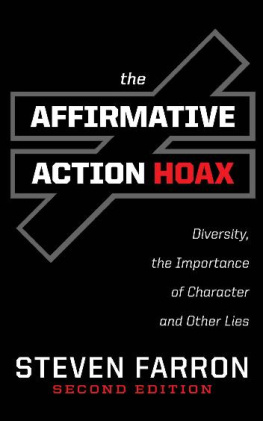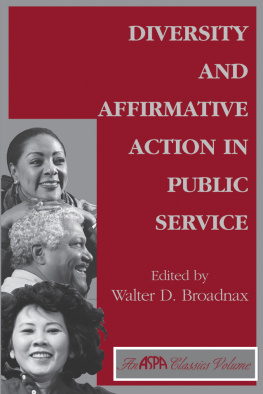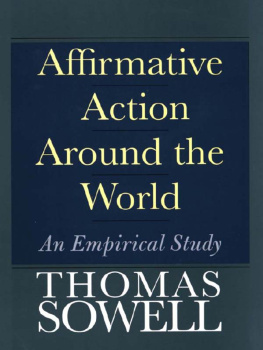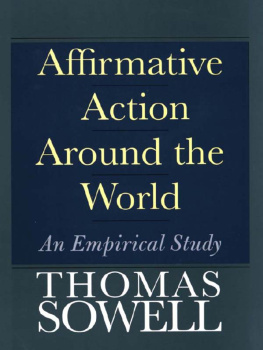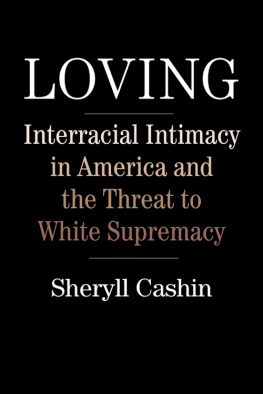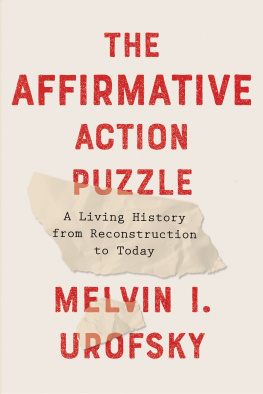Steven Farron - The Affirmative Action Hoax: Diversity, the Importance of Character, and Other Lies
Here you can read online Steven Farron - The Affirmative Action Hoax: Diversity, the Importance of Character, and Other Lies full text of the book (entire story) in english for free. Download pdf and epub, get meaning, cover and reviews about this ebook. year: 2014, publisher: New Century Foundation, genre: Science / Politics. Description of the work, (preface) as well as reviews are available. Best literature library LitArk.com created for fans of good reading and offers a wide selection of genres:
Romance novel
Science fiction
Adventure
Detective
Science
History
Home and family
Prose
Art
Politics
Computer
Non-fiction
Religion
Business
Children
Humor
Choose a favorite category and find really read worthwhile books. Enjoy immersion in the world of imagination, feel the emotions of the characters or learn something new for yourself, make an fascinating discovery.
- Book:The Affirmative Action Hoax: Diversity, the Importance of Character, and Other Lies
- Author:
- Publisher:New Century Foundation
- Genre:
- Year:2014
- Rating:5 / 5
- Favourites:Add to favourites
- Your mark:
- 100
- 1
- 2
- 3
- 4
- 5
The Affirmative Action Hoax: Diversity, the Importance of Character, and Other Lies: summary, description and annotation
We offer to read an annotation, description, summary or preface (depends on what the author of the book "The Affirmative Action Hoax: Diversity, the Importance of Character, and Other Lies" wrote himself). If you haven't found the necessary information about the book — write in the comments, we will try to find it.
Steven Farron: author's other books
Who wrote The Affirmative Action Hoax: Diversity, the Importance of Character, and Other Lies? Find out the surname, the name of the author of the book and a list of all author's works by series.
The Affirmative Action Hoax: Diversity, the Importance of Character, and Other Lies — read online for free the complete book (whole text) full work
Below is the text of the book, divided by pages. System saving the place of the last page read, allows you to conveniently read the book "The Affirmative Action Hoax: Diversity, the Importance of Character, and Other Lies" online for free, without having to search again every time where you left off. Put a bookmark, and you can go to the page where you finished reading at any time.
Font size:
Interval:
Bookmark:
Action Hoax:
Jared Taylor, Ed., The Real American Dilemma: Race, Immigration, and the Future of America, 1998
George McDaniel, Ed., A Race Against Time: Racial Heresies for the 21st Century, 2003
Michael Levin, Why Race Matters: Race Differences and What They Mean, 2005
Carleton Putnam, Race and Reason: A Yankee View, 2006
Samuel T. Francis, Essential Writings on Race, 2007
Jared Taylor, White Identity: Racial Consciousness in the 21st Century, 2011
Jared Taylor, Paved With Good Intentions: The Failure of Race Relations in Contemporary America (20th Anniversary Kindle Edition, 2014, based on First Carroll & Graf Edition, 1992)
American Renaissance
www.amren.com
Copyright 2014 by New Century Foundation
First edition published in 2005 by Seven Locks Press, initial copyright 2005 by Steven Farron
This Kindle edition is based on the First New Century Books Edition, Copyright 2010 by New Century Foundation.
Cover design by Kevin I. Slaughter
Kindle edition prepared by John Vawter
I.
II.
III.
IV.
This text is current as of June 9, 2014 and includes new corrections as well as those from the Affirmative Action Hoax website [web link] dated February 2011.
The print edition contains page footnotes, most of which include content as well as any citations. These notes have been collected and placed at the end of each chapter.
Tables present a problem on e-readers. The tables in this book have been formatted to be as narrow as possible for maximum compatibility, but if a table appears truncated on the right margin or if its distorted by line wraps, please reduce the font size to compensate.
Each table contains a link that moves the table to the top of the current page, so that a maximum amount of data is visible on a single page. This is intended to prevent a table from spanning two pages.
Steven Farron received BA and PhD degrees from Columbia University. Until 2001, he was a professor of Classics at the University of the Witwatersrand in Johannesburg, South Africa. His specialty was ancient Greek and Latin epic poetry, on which he published over 20 articles and a book.
He resigned his academic position in order to devote his time to the study of the catastrophic results of trying to solve the perceived problem of the unequal success of ethnic, racial, and social groups: American affirmative action, the Holocaust, Armenian genocide, slaughter of the kulaks in the Soviet Union, and persecution of Chinese in Southeast Asia and of Indians in East Africa.
For years, Helen Savva, the reference librarian at the United States Government Public Affairs Office in Pretoria, South Africa, and Suzette Jansen van Rensberg of the University of the Witwatersrand Interlibrary Loans Office fulfilled my requests for articles and books with alacrity and efficiency.
It is also a pleasure for me to express my gratitude to my friend Robert Terdiman, who sent me many of the articles from the New York Times from which I quote; to my friend Eugene Valberg and my ex-students Ayal Rosenberg and John Wiblin, who offered helpful comments on some of the content of this book; and to Louis Andrews, who offered valuable observations and encouragement.
Last, but certainly not least, I thank my wife Esther for her enthusiasm, encouragement, and, more practically, proofreading.
The re-issue of this book by the New Century Foundation offered me a chance to correct mistakes in the original edition, to reorganize it; and, most importantly, to add relevant information that became available after its original publication in 2005. These additions have made this second edition one-seventh longer than the first edition. I will advise readers who have the first edition that large-scale changes begin in Section C of Chapter 2.
I will post further additions and corrections on my website [web link], which I will update every six months. That website also contains relevant documents that I have prepared, which can be downloaded.
Affirmative action is the standard euphemism for that type of discrimination meant to solve the perceived problem of the unequal success of ethnic and/or racial groups. In some instancesfor example, against Chinese in Southeast Asia, Indians in East Africa, and Jews in Germany between 1933 and 1939its extent and purpose have been clearly stated. But in the United States, whose ethos is individualistic and democratic and where the victims are the majority, its extent has been hidden and its purpose justified by liberal-seeming excuses. That is why attacks on affirmative action, including this one, concentrate on exposing its extraordinary magnitude and the fraudulence of its justifications.
This book also resembles most other criticisms of affirmative action in that it concentrates mainly, although not completely, on universities. Universities have been at the center of the American affirmative-action debate for two reasons: First, academic ability and achievement can be clearly defined, measured, and, consequently, compared. Second, discrimination at universities is more disturbing than elsewhere, since American universities pride themselves on being bastions of liberalism.
However, this book differs from most criticisms of affirmative action in six ways.
First, it names the premise that is the basis of the vicious anti-white discrimination that has pervaded American society since the 1960s.
Second, it demonstrates that the non-academic admissions criteriadiversity, importance of character, etc.that American universities use to defend anti-white affirmative action never had any purpose except to justify discrimination. No American university ever considered using any non-academic admissions criteria until the need arose to justify discrimination in favor of upper-class, private-school-educated Anglo-Saxons because they could not compete academically with the children of poor, non-English-speaking Jewish immigrants.
Third, it demonstrates that if racial discrimination cannot be eliminated, then by far the most efficient and fairest way to practice it is by explicit quotas.
Fourth, it avoids the gentlemanly self-restraint that inhibits most critics of affirmative action from labeling its defenses as the shameless frauds and deliberate lies that they are.
Fifth, it discusses not only affirmative action in university admissions but also the much more important but much less publicized practice of affirmative grading and graduation.
Sixth, it focuses attention on the damage that affirmative action does to its real victimswhitesinstead of claiming that it harms its black and Hispanic recipients or that Asians suffer worse discrimination than whites. It shows that, on the contrary, the black and Hispanic recipients of affirmative action obtain an undiluted advantage and that Asians also benefit from affirmative action.
Kennedy and Kings Moral Crusade
M ost opponents of anti-white discrimination think that it is a blatant distortion of the non-racialism that was espoused by the two icons of twentieth century American liberalism, President John Kennedy and the Reverend Martin Luther King. As proof, they quote three statements that Kennedy and King made in the early 1960s. One is Section 301 of President Kennedys Executive Order Number 10,925 of March 8, 1961, which contained the first application by the federal government of the term
Font size:
Interval:
Bookmark:
Similar books «The Affirmative Action Hoax: Diversity, the Importance of Character, and Other Lies»
Look at similar books to The Affirmative Action Hoax: Diversity, the Importance of Character, and Other Lies. We have selected literature similar in name and meaning in the hope of providing readers with more options to find new, interesting, not yet read works.
Discussion, reviews of the book The Affirmative Action Hoax: Diversity, the Importance of Character, and Other Lies and just readers' own opinions. Leave your comments, write what you think about the work, its meaning or the main characters. Specify what exactly you liked and what you didn't like, and why you think so.

